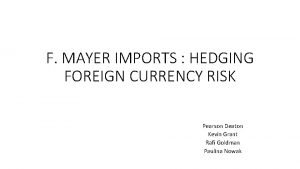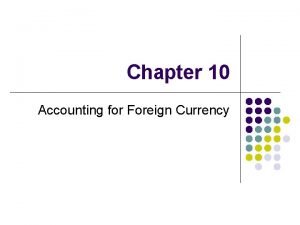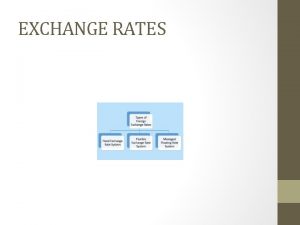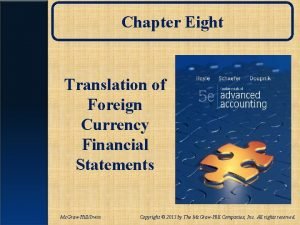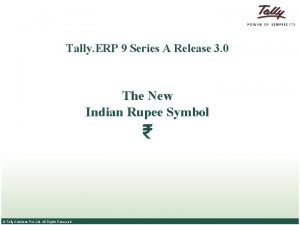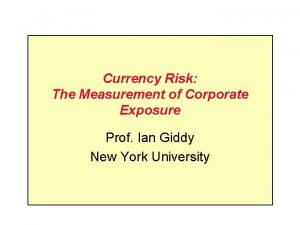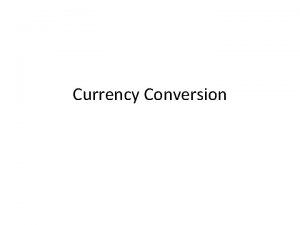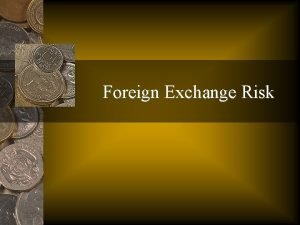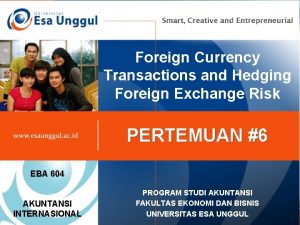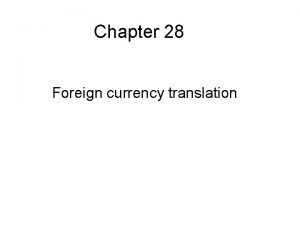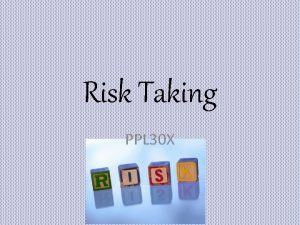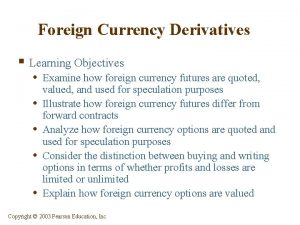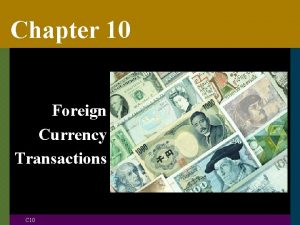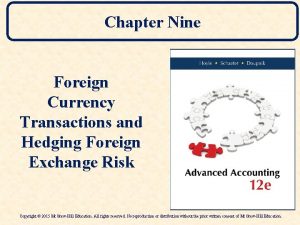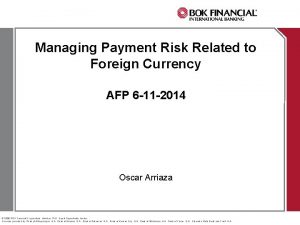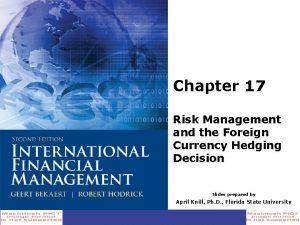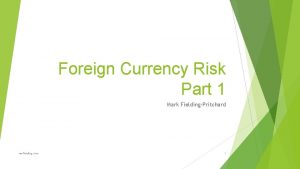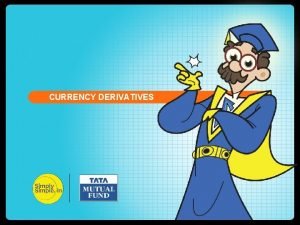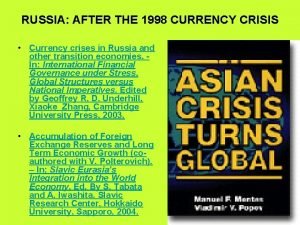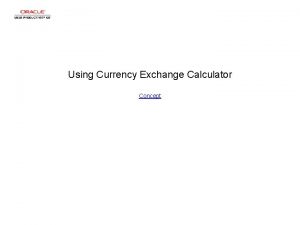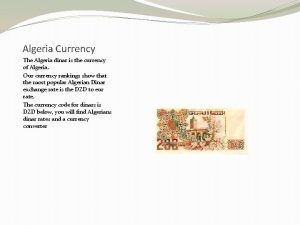Taking the Foreign Currency Risk out of Foreign
























- Slides: 24

Taking the Foreign Currency Risk out of Foreign Investment Ø Asia Pacific Business Outlook Ø University of Southern California March 27, 2007 Ø Presented By: David Gopal, Wells Fargo

Managing Foreign Exchange Risk “We experienced an unfavorable impact to other international revenues due to the strengthening of the dollar relative to other foreign currencies primarily the Euro and the Japanese Yen. ” Google Inc. 12/31/05 10 -K “Foreign exchange had a negative 1% impact on net sales growth, primarily due to the strengthening of the U. S. dollar relative to the Euro, British Pound and Japanese Yen. ” Procter & Gamble Co. 6/30/06 10 -K Overseas investing has its own unique set of risks and foreign exchange is one of the most prevalent! APBO – 2007 2 David Gopal, Wells Fargo

Table of Contents Ø Overview of Hedging Foreign Currency Ø Hedging Foreign Exchange Risk Ø Global Rate Environment – Past, Present and Future APBO – 2007 3 David Gopal, Wells Fargo

Overview of Hedging Foreign Currency

The Foreign Currency Market Ø Scope of foreign exchange market § Volume over $2 Trillion / day § Expansion of product type • Spot, forwards • Options of all types • Cross-currency swaps • Hybrids Ø The participants § Commercial and investment banks (providers) § Companies (hedgers) § Central Banks / Governments § Private Equity & hedge funds (hedgers and speculators) § Wealthy individuals (hedgers and speculators) APBO – 2007 5 David Gopal, Wells Fargo

The Unintended Foreign Currency Position Ø Why are companies investing overseas? § New markets § Greater returns § Generally better or different opportunities Ø Any of the above situations without a foreign currency hedge equals a speculative foreign currency position. APBO – 2007 6 David Gopal, Wells Fargo

Preservation of Value Ø Review of value § The present value of all future cash flows. • Good cash flow estimates and good investment valuation does not mean good return. If the foreign currency weakens, returns will suffer. § Transaction price • The purchase price in foreign currency OR eventual sales price in foreign currency. • An investment into Japan may perform well in local currency, but if the Yen weakens, the realized US dollar sales price will suffer. APBO – 2007 7 David Gopal, Wells Fargo

Private Equity Investment Example Scenario: Private Equity Firm ABC USA purchases a Japanese Company for 1 B Japanese Yen. Assumptions: § 10% annual cash flow § 25% growth at maturity § Current JPY/USD exchange rate is 118 § The exchange rate will remain constant at 118 Inception T 1 T 2 Maturity (1 B JPY) 100 MM JPY 1. 25 B JPY (8. 47 MM USD) 847 K USD 10. 59 MM USD APBO – 2007 8 David Gopal, Wells Fargo

Private Equity Investment Example Ø The future USD amounts depend on the future exchange rate Ø If JPY drops by 10% (to ~130) after investment…. . § 1 B JPY = 8. 47 MM USD investment today (done at initiation) § 100 MM JPY = 770 K USD (~77 K less due to weaker JPY) § 1. 25 B JPY = 9. 63 MM USD (~1 MM less due to weaker JPY) Ø Returns can suffer dramatically due to currency fluctuations! Inception T 1 T 2 Maturity (1 B JPY) 100 MM JPY 1. 25 B JPY (8. 47 MM USD) 770 K USD 9. 63 MM USD APBO – 2007 9 David Gopal, Wells Fargo

Hedging Foreign Exchange Risk

Hedging Considerations Ø Certainty of cash flows § Timing § Amount Ø Risk tolerance Ø Return requirements Ø Company policy Ø Accounting implications Ø Access to markets APBO – 2007 11 David Gopal, Wells Fargo

Product Considerations Ø Derivatives § Forwards § Options § Swaps Ø Structural decisions § Borrowing base § Contract currencies APBO – 2007 12 David Gopal, Wells Fargo

Hedge Products Ø Short-dated hedges § Forwards • Provides a known USD amount against a known currency amount. • Used when there is a known currency amount to be paid (received) in the near future. § Options • Provides a worst case USD amount against a known currency amount. • Used when there is less certainty around whethere will be a currency need or to maintain upside potential. Ø Long-dated hedges § Cross-Currency Swaps • Converts a set of cash flow in currency to USD (or viceversa). in Wells APBO – 2007 • Used when the exposure is long-term or perpetual David Gopal, 13 nature. Fargo

Product – Cross-Currency Swap Ø Cross-Currency Swaps (CCS) are used to convert debt from one currency to another. Ø CCS’s allow companies to synthetically create debt in a currency, which they may normally not be able to access. Ø An initial exchange is not necessary. Initial Exchange of Principal Cross. Currency Swap 1 B JPY Investment USD Debt 1 B JPY XYZ Corp 8. 47 MM USD Periodic Interest Payments Cross. Currency Swap 3 M JPY Libor + 250 bps 3 M USD LIBOR +250 bps JPY Cash Flow XYZ Corp 3 M USD LIBOR +250 bps JPY Investment USD Debt Exchange of Principal – At Maturity Cross. Currency Swap APBO – 2007 21 B JPY XYZ Corp 8. 47 MM USD 14 JPY Investment USD Debt David Gopal, Wells Fargo

Product – Cross-Currency Swap CCS – Synthetic Foreign Denominated Loan Ø From XYZ’s perspective, all USD payments (principal and interest) net to zero. They are left with a principal inflow in JPY at inception, JPY interest payments throughout the life of the transaction, and a final JPY principal repayment. This perfectly replicates a loan in JPY. In other words, XYZ has borrowed JPY synthetically. CCS – Rationale for Hedging Ø The initial exchange provides JPY funding for the investor. The final exchange provides a return of principal at the initial exchange rate, thereby hedging the currency risk. Ø Interest rate savings – It is often possible to swap to a lower non-US rate environment. In this example, the company is saving nearly 5% annually, which greatly enhances investment returns. Ø Access to capital – Many companies do not have access to foreign capital. Others can tap foreign markets, but not efficiently. In this case, synthetic borrowing can be cheaper. APBO – 2007 David Gopal, Wells Ø No requirement for new capital – 15 Companies can swap pre-existing debt Fargo to other currencies at any time.

Private Equity Investment Example - Hedged Ø Same Investment + Cross-Currency Swap § The Investor can deliver 100 MM JPY / Year and 1. 25 B JPY in 2 years. § The Investor will receive 847 K USD annually PLUS an additional amount due to the higher interest rates in the US. This additional amount is approximately 350 K. So the total annual cash flow will be ~1. 2 MM USD. § The Investor will receive back 10. 59 MM USD at maturity. Ø Results of hedge § Currency risk is eliminated Inception T 1 T 2 Maturity § Return is enhanced* (1 B JPY) 100 MM JPY 1. 25 B JPY (8. 47 MM USD) 1. 2 MM USD 10. 59 MM USD *The enhancement is directly related to the interest differential. When hedging back to a currency with a higher interest rate, the differential can be earned. APBO – 2007 16 David Gopal, Wells Fargo

Foreign Investments without Currency Risk Ø Not all foreign investments are foreign currency investments § Offshore manufacturing of product to be sold in USD § China or Hong Kong investment where the currency is fixed to the USD* § Desired foreign currency risk / portfolio diversification § Business risk / currency correlation – Business improves when foreign currency weakens and vice versa *There is no guarantee that these exchange rates will stay fixed in the future. APBO – 2007 17 David Gopal, Wells Fargo

Global Rate Environment Past, Present, Future

The Dollar Ø The dollar appreciated from 1995 - 2001 § Strong Economic Growth § Low Inflation / High Productivity § Equity Markets providing high returns Ø The dollar reversed from 2001 - 2004 § Equity bubble “popped” § The Fed cut interest rates drastically § The dollar reverted to the mean…and then some Source - Bloomberg APBO – 2007 19 David Gopal, Wells Fargo

Historical Interest Rates Ø Today, Central Banks tend to have more stable and transparent policies § Rates are less “choppy” § Transparency reduces volatility § Japanese rates have not always been zero! Source - Bloomberg APBO – 2007 20 David Gopal, Wells Fargo

Current Interest Rate Environment Ø US rates are relatively high § A long string of Fed hikes has put US rates above most other countries § The ECB has been less “hawkish” as European growth has been sluggish § The BOJ has kept rates abnormally low as the Japanese economy has suffered a long bout of economic weakness Source - Bloomberg APBO – 2007 21 David Gopal, Wells Fargo

Foreign Currency Outlook Ø According to Bloomberg surveys: § The Euro will finish 2007 slightly stronger § The Yen will appreciate 5% § The Fed Funds rate will be 5% (one more rate cut) Ø According to market pricing: § The Euro will finish 2007 slightly stronger § The Yen will appreciate 4% § The Fed will cut one or two more times Ø Considerations § Strong US economy - Unemployment and growth 4. 5% and 2. 0%, respectively § Moderate Euro economy – Unemployment and growth 7. 4% and 0. 9%, respectively § Recovering (? ) JPY economy - Unemployment and growth 4. 0% and 2. 3%, respectively APBO – 2007 22 David Gopal, Wells Fargo

David Gopal (415) 371 -6651 David Gopal is a Derivatives Specialist working for the Wells Fargo Risk Management group in San Francisco. Specializing in crosscurrency swaps, David focuses on developing effective solutions for clients that minimize their foreign currency and interest rate exposure. He is also an expert on accounting regulations inherent within foreign currency and interest rate derivative structures and is able to help his clients by utilizing his strong knowledge of world currency and interest rate markets. David comes to the Risk Management team with over nine years of international finance experience gained from his tenure with a major east coast bank. He specialized in trading spot, forward and option products and was later charged with selling FX and interest rate products to corporate clients before joining Wells Fargo. David earned his MBA from the Duke Fuqua School of Business Durham, North Carolina and received a BA in economics and psychology from Claremont Mc. Kenna College in Claremont, CA. He also holds the Chartered Financial Analyst (CFA) designation. APBO – 2007 23 David Gopal, Wells Fargo

Important Explanations & Disclaimers – PLEASE READ Ø All derivatives transactions are arm's-length transactions, and each party is expected to negotiate with the other party at arm's length and in its own best interests. The decision whether to proceed with any transaction, and the terms and conditions thereof, rests solely with you. In our written and oral communications relating to any proposed transaction, we are not giving any economic, tax, accounting, legal or regulatory advice or recommendations, and are not acting in a fiduciary relationship. You should conduct a thorough and independent review of the economic, tax, accounting, legal and regulatory characteristics, consequences and risks of the transaction in light of your particular circumstances, consulting with such advisors as you consider appropriate. Ø All amounts, terms and conditions in our communications are estimates as of a particular date for indicative purposes only. They should not be relied on as amounts, terms or conditions on which we or anyone else would at any time be willing to enter into, terminate or transfer a transaction, or relied on for any other purpose. They may be based on market information we obtained APBO – 2007 David Gopal, Wells from secondary sources without are 24 independent verification, and Fargo not binding on us in any way.
 F. mayer imports: hedging foreign currency risk
F. mayer imports: hedging foreign currency risk The biggest risk is not taking any risk
The biggest risk is not taking any risk Forex accounting
Forex accounting Foreign currency exchnage
Foreign currency exchnage Translation of financial statements
Translation of financial statements Www tallysolutions com
Www tallysolutions com Market risk credit risk operational risk
Market risk credit risk operational risk One direction one thing lyrics
One direction one thing lyrics Measuring currency risk
Measuring currency risk Too foreign for home too foreign for here
Too foreign for home too foreign for here Positive risk-taking dementia
Positive risk-taking dementia What is risk projection in software engineering
What is risk projection in software engineering Risk avoidance
Risk avoidance How to calculate relative risk
How to calculate relative risk Residual risk and secondary risk pmp
Residual risk and secondary risk pmp Tracing vs vouching
Tracing vs vouching Absolute risk vs relative risk
Absolute risk vs relative risk Activity sheet 2: to risk or not to risk?
Activity sheet 2: to risk or not to risk? Classification of risk
Classification of risk Pembiayaan risiko (risk financing)
Pembiayaan risiko (risk financing) Key risk indicators for vendor management
Key risk indicators for vendor management Ir x cr x dr
Ir x cr x dr Business risk and financial risk leverage
Business risk and financial risk leverage Relative risk calculation
Relative risk calculation Risk map risk management
Risk map risk management
